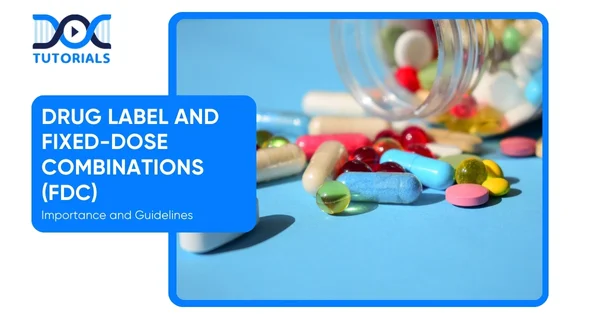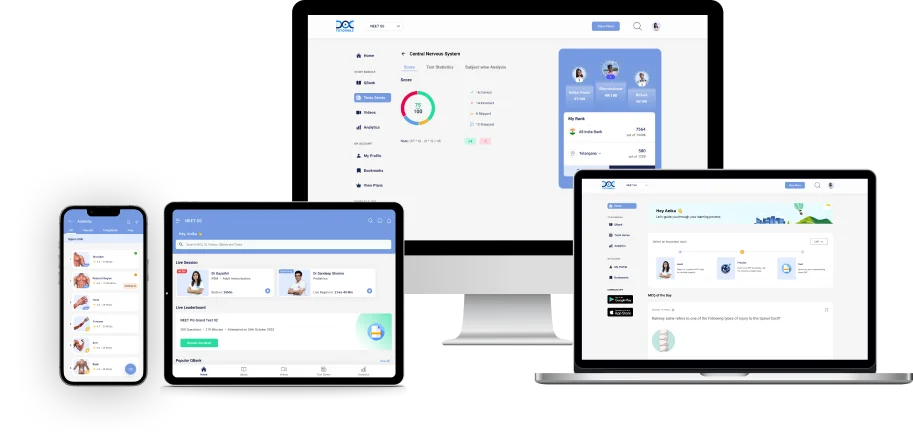Drug Label and Fixed-Dose Combinations (FDC): Importance and Guidelines

Drug labelling ensures every medicine has composition, dosage, uses, risks and side effects—critical for safe administration and patient awareness. In clinical practice, multiple medicines are prescribed together and many times combined into a single formulation called a Fixed Dose Combination (FDC).
For NEET PG aspirants, mastering this topic helps in understanding rational drug use and prescribing ethics—a skill every future clinician should have. Read on to know how labels and FDC rules impact safe medical practice.
What are Drug Labels and FDCs?
Any written, printed, or graphic matter appearing on the label of a drug product refers to drug labelling. It contains information such as directions for use, dosage, warnings, etc., to ensure that doctors and patients use the drug correctly and safely.
An accurate label will guide against misuse of the drug, leading to side effects and uphold professional and regulatory standards. A fixed-dose combination (FDC) contains two or more active drugs that are combined in certain fixed proportions within a single dosage form for a common therapeutic indication.
Most often, these FDCs are used to simplify treatment schedules, thereby improving patient compliance and eliminating the need to adjust doses of individual drugs.
What is the Importance of Drug Labels and FDCs?
Drug labelling is key to patient safety and treatment. It gives doctors and patients the information they need – what the drug is for, what the side effects are, what to be careful of and how to take it. This ensures the right medicine is used for the right patient in the right way, minimising misuse and improving outcomes.
Fixed dose combinations (FDCs) are good when they offer clear therapeutic benefits. They are justified if:
- They increase the therapeutic effect
- Reduce adverse effects
- Offer pharmacokinetic advantages
- Reduce pill burden
- Allow lower doses of individual drugs
- Reduce the risk of resistance
- Reduce overall cost from packaging to distribution
What are the Guidelines for Drug Labels and FDCs?
Correct and clear labelling of a drug is crucial for its safe administration and proper use. An appropriately structured label gives a healthcare provider or patient all the information needed to use the drug correctly and prevent harm.
Key components of a drug label include:
- Product Name – Official name often includes generic and brand names.
- Active Ingredients – Therapeutic substances present in a formulation.
- Uses – Diseases and medical disorders that the drug is said to successfully treat.
- Warnings – Precautions regarding safety factors, side effects, and contraindications.
- Instructions – Dosage, frequency, and instructions on food intake.
In the case of FDC labelling, the Dosage and Administration (D&A) section is very important. It should:
- Clearly describe the recommended dose and administration methods.
- Include statements about dose adjustments in certain populations, adverse reactions, and drug interactions.
- Specify what supportive therapies are to be followed before, during, and after treatment.
- Include instructions for storage of reconstituted and/or diluted products.
What are the Problems Associated with Fixed-Dose Combinations?
If poorly designed, fixed-dose combinations can pose more risks than benefits, such as:
- Pharmacodynamic Mismatch – Cases where one drug’s effect may either counteract the other or excessively amplify each other’s toxicity, thus diminishing the desired effect.
- Pharmacokinetic Mismatch – When each component reaches peak activity at a different time, it results in inconsistent therapeutic results.
- Chemical Incompatibility – Shortens the shelf-life of the product and hence compromises stability.
- Drug Interactions – Shared metabolic pathways may cause undesired interactions of a harmful nature.
- Dosing Limitations – Prevent the needed fine-tuning of doses between the individual ingredients.
What is the Overview of Drug Schedules?
Drug schedules under the Drugs and Cosmetics Act, 1940, are employed for classifying drugs, biological products, cosmetics, and such related substances in accordance with their regulatory requirements, usages, and safety considerations.
Each schedule prescribes the rules for licensing, manufacturing, storage, prescription, sale, and record-keeping matters. Key highlights include:
- Schedule A – Forms and formats for application for licenses.
- Schedule B – Fee structure for government-run laboratories.
- Schedule C – Biological products such as serums, adrenaline, or vitamins with special regulations.
- Schedule D – Drugs exempt from import provisions of certain varieties.
- Schedule E – Poisons such as snake venom (Sarpa Visha) and mercury (Parada) with their control measures.
- Schedule F – Standards relating to blood banks.
- Schedule F-I – Regulations of vaccines.
- Schedule F-II – Standards for surgical dressings.
- Schedule F-III – Regulations of umbilical tapes.
- Schedule F-F – Standards for ophthalmic ointments and solutions.
- Schedule G – Schedule G drugs are those drugs which require to be used strictly under medical supervision.
- Schedule H – Drugs under the 1945 Act, to be sold by retail on the prescription of a registered medical practitioner.
- Schedule K – Drugs which are sold by retail without prescription.
- Schedule M – Guidelines for manufacturing, premises, waste disposal, and equipment.
- Schedule N – Requirements for running a pharmacy.
- Schedule O – Standards for disinfectant fluids.
- Schedule P – Shelf life and storage requirements of drugs.
- Schedule P-I – Rules for retail packaging sizes.
- Schedule Q – Record-keeping regulations.
- Schedule R – Standards for condoms and other contraceptives.
- Schedule S – Cosmetic and toiletry standards conforming to BIS (Bureau of Indian Standards) requirements.
- Schedule T – Regulations for the manufacture of Ayurvedic, Siddha, and Unani products.
- Schedule U – Record-keeping for drugs.
- Schedule V – Standards for drug patents.
- Schedule W – List of generic drugs.
- Schedule X – Highly narcotic and psychotropic drugs such as ketamine, phencyclidine, and secobarbitone
- Schedule Y – Guidelines for clinical trials.
FAQs about Drug Labels and FDCs
- What is an FDC in pharmacology?
The FDC in pharmacology usually means two or more drugs combined in a fixed ratio within a single dosage form. They are used for the treatment of a single disease or multiple co-existing conditions.
- What information is on a drug label?
The label will include the name of the manufacturer or distributor and the manufacturer’s instructions for use. It specifies the purpose for which the drug is intended, the dose, the timings, and the route of administering the drug.
- What is the full form of FDC in pharmacy?
FDC in pharmacy means Fixed-Dose Combination, which is a single dosage form that contains two or more drugs in fixed proportions for a medical purpose.
- Why are drug labels important?
Labels ensure that drugs are used properly. It instructs patients on how to take a drug or medication in the correct dose and cautions against harmful interactions with other medicines, certain kinds of food, or drink.
Conclusion
Drug labelling and fixed-dose combination (FDC) medicines are vital for a safe, effective, and patient-centred medical practice. Proper labelling ensures that every single medicine is being used for the right purpose, and well-designed FDCs may result in better treatment outcomes, patient compliance, and less cost to the patient.
If you are a medical student, DocTutorials offers a range of supplementary topics, including question banks, high-quality video lectures, test series, expert advice, and more.
Check out our NEET PG course to take your preparation to the next level!
Latest Blogs
-
-

NEET SS Exam 2024: Analysis, Key Dates, Counselling
The NEET SS 2024 exam kicked off on March 29, 2025. Over two days and two slots, candidates across 13…
-

NEET PG Registration 2025: An Essential Guide For Exam Prep
The NEET PG registration, which is conducted online, is a crucial step in the exam process. Filling out the NEET…





